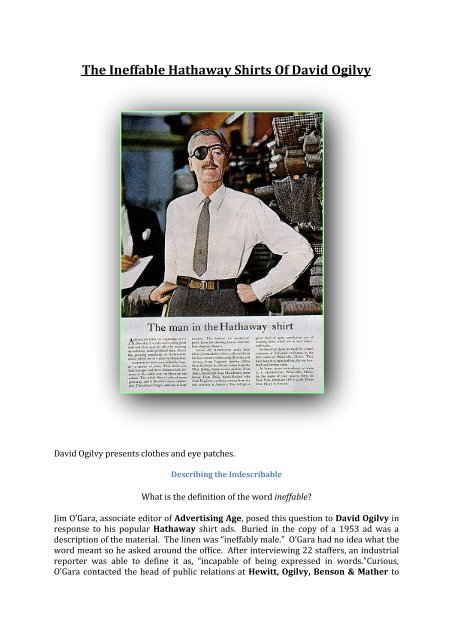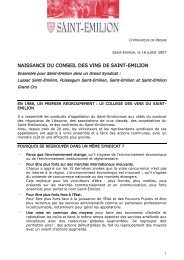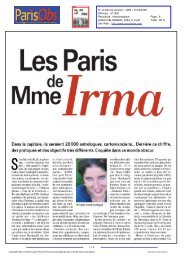The Ineffable Hathaway Shirts Of David Ogilvy - Ionis-group
The Ineffable Hathaway Shirts Of David Ogilvy - Ionis-group
The Ineffable Hathaway Shirts Of David Ogilvy - Ionis-group
Create successful ePaper yourself
Turn your PDF publications into a flip-book with our unique Google optimized e-Paper software.
<strong>The</strong> <strong>Ineffable</strong> <strong>Hathaway</strong> <strong>Shirts</strong> <strong>Of</strong> <strong>David</strong> <strong>Ogilvy</strong><strong>David</strong> <strong>Ogilvy</strong> presents clothes and eye patches.Describing the IndescribableWhat is the definition of the word ineffable?Jim O’Gara, associate editor of Advertising Age, posed this question to <strong>David</strong> <strong>Ogilvy</strong> inresponse to his popular <strong>Hathaway</strong> shirt ads. Buried in the copy of a 1953 ad was adescription of the material. <strong>The</strong> linen was “ineffably male.” O’Gara had no idea what theword meant so he asked around the office. After interviewing 22 staffers, an industrialreporter was able to define it as, “incapable of being expressed in words.”Curious,O’Gara contacted the head of public relations at Hewitt, <strong>Ogilvy</strong>, Benson & Mather to
further investigate. After several unsatisfactory answers from the staff, <strong>Ogilvy</strong> wasquestioned and caught off guard.“I think it means ‘supremely’,” he said, “… but I think it’s a dreadful phrase, and I wish Ihadn’t used it.”Borrowing From <strong>The</strong> BibleLater that day <strong>Ogilvy</strong> called O’Gara back with a much more satisfying answer. Headmitted nipping the word from a hymn based on Psalm 104. Though not cited, there isa passage that references clothing: “Who coverest thyself with light as with a garment:who stretchest out the heavens like a curtain.”<strong>Ogilvy</strong> later said, “I am pretty sure it came from the Bible or a hymn … practicallyeverything I’ve stolen came from one or the other.”<strong>The</strong> lesson? Confusion can be avoided by using everyday words. As was the case withO’Gara, you don’t want a word or poor phrasing to overshadow the product you areselling.In his 1983 book <strong>Ogilvy</strong> on Advertising, <strong>Ogilvy</strong> described his method for dealing withcopywriters that insist on using flowery words they read in a Keats poem. “Whencopywriters argue with me about some esoteric word they want to use, I say to them,‘Get on a bus. Go to Iowa. Stay on a farm for a week and talk to the farmer. Come backto New York by train and talk to your fellow passengers in the day-coach. If you stillwant to use the word, go ahead.’”And About That Eye Patch…<strong>Ogilvy</strong>’s agency was only a couple years old when it began work for the Maine clothingmanufacturer. A story approach was employed to generate an air of sophistication forthe product.Art director Vincent DeGiacomo selected model George Wrangell because of hisdistinguished look and <strong>Ogilvy</strong>’s insistence that he look like a writer and have amustache. On the way to the shoot, <strong>Ogilvy</strong> bought an eye patch. He had a weirdobsession with eye patches that began at 10 years of age (he had a stylish teacher thatrocked one). Two versions of the ad were shot: a plain version and an eye patchversion. <strong>Ogilvy</strong> explained to the client that the eye patch would attract the curiosity ofreaders.<strong>The</strong> ad debuted in the September 22, 1951 issue of the New Yorker. For four years theyonly appeared in the magazine (high end magazine = high end product). Annual salestripled.And magazines like Ad Age and Newsweek wrote articles on it.“<strong>The</strong> Unspeakable Ad,” Newsweek, March 9, 1953.





